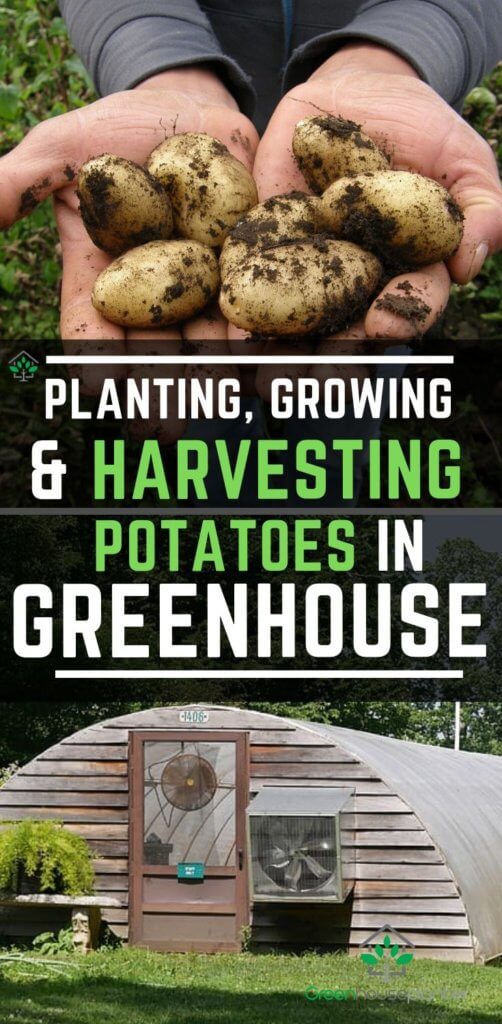![]()
Plant Dreams, Grow Gardens
Finding a suitable temperature and growing conditions for potatoes inside the greenhouse isn’t impossible, though it is a time-consuming process. But I would love to put my efforts into growing one of my favorite vegetables inside my greenhouse. I am pretty sure you want the same. So, in today’s blog, we will tell you: How and when to plant, grow and harvest the yummiest potatoes inside your greenhouse?
For growing potatoes inside your greenhouse, fill half of the 1-feet high raised-bed with well-drained nutrient-rich soil of slightly acidic pH. Bury the seed potatoes 4 inches deep into the soil and choose a location inside your greenhouse with maximum sunlight. Water your greenhouse potatoes regularly and keep adding soil as the potato sprouts grow till you reach the top of the raised bed. Your greenhouse potatoes will be ready for harvest after the foliage has dries out.
Unlock the potential of your garden with GreenhousePlanter – explore our PRODUCTS today!
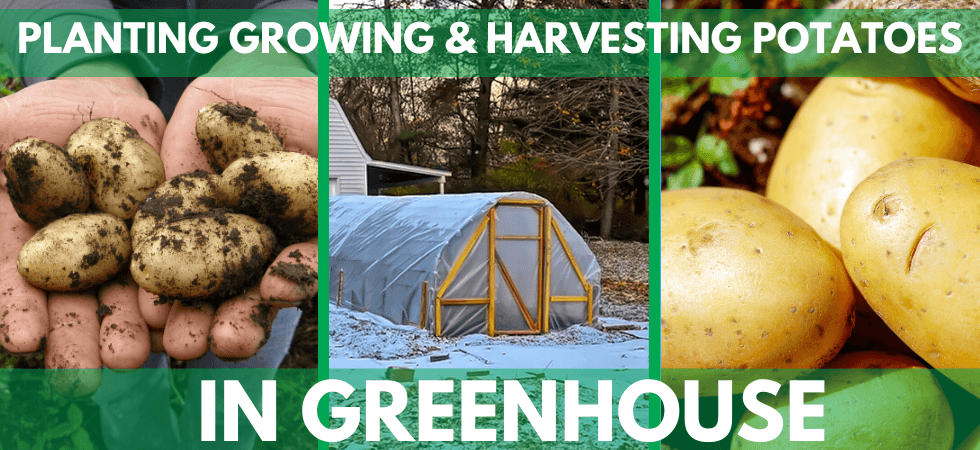
Before proceeding with the article I would like to thank all of our viewers and especially those who comment on our articles. We’ve checked all of your comments.
Enjoy reading this article!
“What I say is that if a man really likes potatoes, he must be a pretty decent sort of fellow.”
–A. A. Milne, English writer (1882–1956)
Potatoes are root vegetables just like onions and garlic. However, potatoes are not normally grown from seeds just like other vegetables. This vegetable is actually grown from Seed Potatoes, i.e the potatoes which have eyes or buds on them.
A single seed potato is usually cut into multiple pieces with at least one eye bud on each piece. This practice is usually followed by framers who are aiming for a large harvest from minimal seed potatoes.
You can also grow potatoes from seeds, However, potatoes that are grown from seeds are not the same as that of the parent potatoes. Therefore, growing potatoes from seeds are highly discouraged.
Now, lets discuss about the popular potato varieties that you can grow.
There are more than 4000 different types of potato varieties and they come in different shapes and sizes. There are also around 180 wild potatoes species that are very bitter in taste. Around different 200 varieties of potatoes are sold throughout the united states. All of the 200 potatoes varieties fall into 7 categories. These are russet, yellow, red, white, blue/purple, fingerling, and petite.
You can grow all of the above-mentioned types of potatoes in your greenhouse. Lets discuss these potato categories types in detail.
Russets are also called old potatoes and baking potatoes. The popular russets varieties include russet Burbank, russet Arcadia, russet Norkotahs, and russet Butte.
These potatoes have an elliptical shape with a rough, netted brow skin. These potatoes are low in moisture and they dry up and become fluffy when cooked. Thy are suited for deep frying (Fresh Fries), mashing and baking.
The potatoes varieties like Yukon gold, German Butterball, yellow Finn, Carola, Nicola, and Alby’s Gold come in yellow category.
These are round, medium sized potatoes with thin light brow or yellowish skin and are golden wax from the inside. These potatoes has buttery flavour and they are suited for roasting, mashing, boiling, grilling and steaming.
Round red potatoes are mostly grown in Northwestern United States and they include varieties like red Norland and red Pontiac.
The potatoes have round with reddish-brown skin with dense white flesh. Round red potatoes are sweeter in taste than round white potatoes. These potatoes are suited for roasting, grilling, boiling, salads, and stews.
Fingerlings are thumb size potatoes that can grow up to 3 inches. They include potato varieties like purple Peruvian fingerlings, long white fingerlings, Russian banana fingerlings, and Ruby crescent fingerlings.
The potatoes have thin skin and they can be cooked unpeeled. These potatoes have yellow skin and they have buttery inner texture. These potatoes are suited for baking, boiling, deep frying, roasting and steaming.
The potatoes varieties like Kennebec, Superior, and Atlantic falls in round white potatoes category.
There are medium sized, round potatoes with freckled brow skin. These potatoes have creamy textured flesh and are well suited for frying, mashing, boiling and roasting.
Purple potatoes are also know as blue potatoes. The potatoes include varieties like All blue, Purple Peruvian and Purple Viking.
These are actually heirloom potatoes with purple or greyish-blue skin and they usually have inky blue flesh. These potatoes have a delicate flavor and are suited for roasting, frying, mashing, steaming, stews, and salads.
These potatoes are also called new potatoes, baby potatoes, and creamers because they have been harvested before it has reached maturity (when the leaves are still green). They can be very small in size.
New potatoes are very crisp and have waxy inner texture. They are suited for cooking as hole, roasting and boiling and salads.
If you are panning to grow potatoes outdoor then you will have a number of different restriction that will determine the variety of potatoes you should opt for. For example, You should check the environmental conditions of your zone where you you live. How cold does it gets ? How long is the winter seaseon etc.
Beside these constraints you should also check your soil type weather it is too sandy or has high clay content. If your soil type is sandy then drought varieties like the rose finn apple will work best on the other hand for soil with high clay composition red chieftain will work best.
You see you have a lot of limitations on the type of potato variety you can grow outdoor, however, inside a greenhouse temperature is much stable, the growing season is longer and the soil composition can be altered easily as per the requirement of the specific variety you wanna grow. So, now you can grow your favorite potato variety without any worry. This is why I am addicted to greenhouses.
The only this that you should consider when you are growing potatoes in your greenhouse is the expected harvesting time. You should the expected that that a particular variety of potatoes will reach maturity. So, you can choose a combination of varieties for you greenhouse with early and late expected harvest dates. So, you can have a long season of greenhouse potatoes.
You should note that the potato varieties that reach maturity sooner are also smaller in size. Hence, if you are fond of large potatoes then you will have to be patient.
Early Harvest Varieties: Red Nroland, Irish Cobbler
Late Harvest Varieties: Chieftain, Cranberry Red, Gold Rush
Potatoes can be propagated from Tubers, Tissue culture and from Ture Seeds.
You probably have seen eyes (also called as nodes) growing on your old stock of tomatoes. These potatoes are called as Tubers.
Potato tubers are actually a modified stem with approximately 70-75% content of water and a remaining 25-30% of dry mater.
if you want to have many potatoes seeds you will have to cut the potato in to many pieces such that each piece has its nodes. The tubers should have size of at least 2 ounces and size of 2 inch cubes. Cutting the poatoes at this size will make sure that the potato sprouts have enough carbohydrates for proper initiation and growth.
You should let the poatoe pieces to cure for around 10 days so they can develop a corky layer which will prevent it from decaying when planted.
Propagating potato from tuber is the most common method which is used by most of the potato farmers and gardeners. Actually, when the potatoes go through the period of dormancy they sprout several nodes. The dormancy period varies according to the variety.
From these sprouts emerge a potato plan with many shoots and branches and in the soil the plant produces more tubers which will turn into potatoes as the plant matures.
This is an asexually (vegetative) propagation method of potatoes and is very different from other vegetables that propagate from the seeds of the harvested veggies. The benefit of this propagation mentioned is that the tuber (the tomato seed which we planted) and the harvested potatoes are actually genetically exact replicas of each other.
However, there is a serious drawback of propagating potatoes using tubers that if your tuber is effected by mold (blight-causing mold) or virial infection then it would be transferred into the harvested potatoes. Which is very alarming.
Therefore, I will highly recommend buying tomato seeds from highly reputable seller and make sure that you buy certified disease-free tubers.
This method has low rate of propagation and high risk of disease transmission.
Tissue culture is becoming very popular as an alternative means for vegetative propagation of plants. Tissue cultures are making its place in modern agriculture because it provides the opportunity to meet the increasing demand of potatoes.
In Tissue culture plants are grown in test tubes in a liquid medium full of nutrients. As the plants grow they are cut at the nodes and the cuttings are growing separately in another test type. (see source)
Using tissue culture a large number of clones can be produced from a single seed or explants (more than 100000 from a single plant). These methods allow us to introduce desirable properties in the plants (increasing the harvest per plant, decreasing the space requirement, etc ). This process of propagating potatoes is free of viral infections because of the careful selection and sterile techniques.
Most of us think that potatoes don’t set fruit and flowers because we have never seen someone practising growing potatoes from seeds.
Yes potatoes do produce fruit and yes the fruit from potatoes contain seeds. A large number of potato varieties sets fruit and some varieties don’t. The fruit of potatoes is just like a small green tomato and it contains seeds (300 seeds on average).
Never eat the fruit of potatoes they are not edible. They are actually poisonous because they contain large amount of solanine which will cause illness when consumed.
You can grow potatoes from these True Seeds however, the plants that you will get from these seeds will be totally different. They will not be genitally identical to their parent plant.
So, you will not know what you will get from the crop. Some of the potatoes might be great and tasty, while others will be bitter and taste bad. The sizes, shape, and color of the potatoes might vary from plant to plant. Therefore it is not recommended to grow potatoes from true seeds when you are in to farming.
But, for experimental purposes you can definitely try growing potatoes from seeds.
Potatoes like cool temperatures, a loose soil that is about 45 to 55°F (7 to 13°C) and good drainage. In warmer climates, potatoes can be grown as a winter crop.
What else they require?
Well, not much they need full sun exposure, like to grow in acidic pH soil and need soil type to be sandy. Therefore, the winter season is best for growing potatoes in your greenhouse. However, you might need some supplementary artificial lighting if sun exposure is less than 6 hours.
It is advised to plant potatoes 0 to 2 weeks after last spring frost (if you are planting potatoes outside the greenhouse).
How can we know the exact dates to plant potatoes in the greenhouse?
Let me guide you – we need to know: What are Frost dates? It is the mean date of the first and last frost also known as light freeze, where temperatures lower down and there is moisture in the surrounding air. Frost usually occurs in spring or fall.
One another thing that should be considered is the topography and your regional weather because these two things also cause considerable variation. Now there is no need to wonder when to plant potatoes inside your greenhouse. You can easily see planting calendar or browse frost date locations by state or province. Happy!
Freeze temperatures are classified on their effects on plants these are:
Now, you know how to and when to plant just by entering your ZIP code to see frost dates for your local area. See how handy it is.
Hence, If you are growing outside then you can plant potatoes in the greenhouse (in containers and potato towers) through April and June.
However, if you are growing in an uncontrolled greenhouse (without lighting and temperature control) you can easily plant your potatoes in early March.
On the other hand, if you have a temperature-controlled Greenhouse, then you can plant it as early as late February. Even if the temperature is adequate during the winter season there will not be enough light for your potato plants to thrive.
On the other hand, If you want to grow potatoes during winter, then you will be needing supplementary artificial lighting for your greenhouse potatoes. In that case, you can plant potatoes during autumn and during winter you will have to provide your potato plants will supplementary lighting.
After knowing when to plant potatoes now we need to know how to plant them. Let us see.
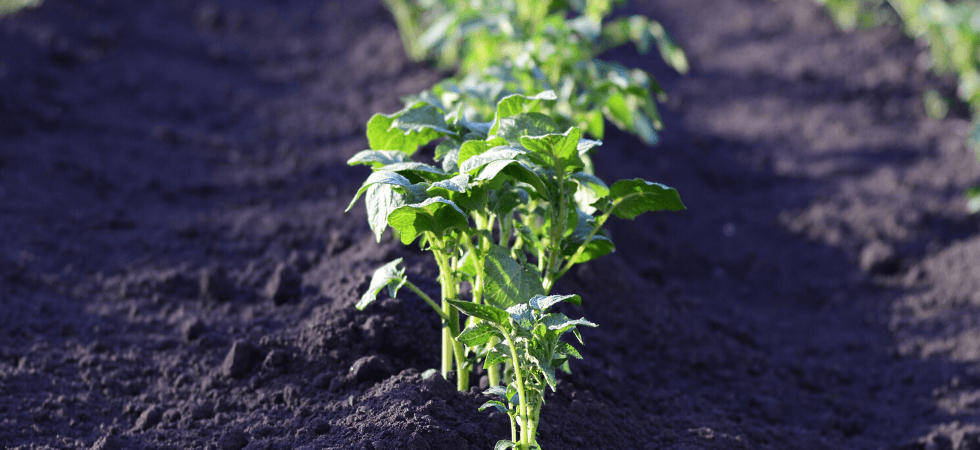
Dig a trench inside your greenhouse, with the help of a round-pointed shovel about 8 inches deep and 6 inches wide. Narrowing towards the bottom to about 3 inches wide.
After digging trench, we have to give it a row shape. Why? Because potatoes are best grown in rows. The Spacing between the rows should be 2-3 feet apart.
In the bottom of the trench in your greenhouse, top-dress the soil with organic compost (will help in retaining moisture) or well-rotted manure (helps in lowering the soil’s pH and we all know now that potatoes like to grow in acidic soil. It will also add in nutrients). In easy terms, we call it poultry manure.
After adding in manure, now we need to place a potato seed piece inside the trench with its cut side down. The piece should be blocky and weigh about 1-1/2 to 2 ounces with at least two eye or recessed dormant buds. With 12 to 14 inches distance between every potato seed piece and cover it with 3 to 4 inches of soil.
Take a clean, sharp paring knife and cut large potatoes into pieces that should weigh about 2 ounces about the size of a golf ball. Don’t miss out eyes there should be at least two eyes or buds on each piece before you plant them. You should not overlook seed potatoes from which buds (eyes) project. These are considered and experimentally proven to be the best starters when growing potatoes inside the greenhouse.
It is advisable to cut up potato pieces, 1 to 2 days before planting inside the greenhouse. Why? Because by doing so, it will retain moisture and will be resistant to rot. Cutting up potatoes 1 to 2 days before sowing them in a greenhouse gives them the possibility to form a protective layer over the cut surface.
Potato sprouts will emerge after 12 to 16 days of planting, as soon as you see these appearing, use a hoe, fill in the trench with an additional 3 to 4 inches of soil. Leaving a few inches of sprouts exposed. We need to repeat this for several weeks, leaving the soil mounded up 4 to 5 inches above ground level. This step is known as hilling.
Add organic mulch between the rows so that the plant has enough moisture, is resistant to weeds; just after the potato plant has emerged.
Normally in greenhouses space is scarce, hence most of the greenhouse growers plant potatoes in their greenhouse raised beds. So, can you.
For growing potatoes your greenhouse raised bed should be at lest one feet high and should span an area of at least 3 by 3 feet. Make sure that your greenhouse raised bed get at least 6 hours of sunlight a day.
Add around 5 inches of compost mix and then plant your potatoes seeds 3 inches deep and space it 12 inches apart.
when the sprouts emerge and the are 4-5 inches fill the raised bed with more compost mix so that 2.5 inches of the sprouts are above the ground.
Keep repeating this process until you reach the top of the raised bed and leave the sprouts to grow.
If you have properly added manure-based compost then you have covered all of the nutrients (phosphorus, potassium, etc) and you just need to give nitrogen to greenhouse potatoes. However, if you want to grow using the organic route. then you can add a small amount of partially decomposed compost which has a hight nitrogen concentration.
Before adding anything to your greenhouse soil, test it to see what is already there. Having good soil matters a lot because it is the primary source of nutrients and water. Every soil is not going to be perfect it needs treatment before it is acceptable in quality. What we need to do is? get the greenhouse soil tested simply by buying soil test kit which is not expensive. Then comes soil pH, it is another important factor to decide which veggies need to be planted. Acidic soil allows the growth of potatoes, blueberries and etc, while alkaline pH soil and higher allows the growth of cabbage. Knowing your soil pH will also allow us to tailor our fertilizers based on what our greenhouse soil actually requires. The next thing to keep in mind is the Ideal soil pH, normally, greenhouse soil falls between pH 5 and 9 on the scale. It never reaches the upper and lower limits of the pH scale. What is the ideal soil pH for plants? The ideal pH for most of the vegetable crops is between pH 6.0 and 6.5, this pH favors peak microbial activity, as well as plant roots, access nutrients best when soil pH falls within this category. After testing the soil pH inside the greenhouse, and you find out it’s not within the ideal range of 6.0- 6.5. What you have to do at this point? We, need to adjust soil pH, if its too acidic raise soil pH, by adding lime (pulverized limestone) or wood ash to the greenhouse soil. If the soil pH is alkaline and you need to grow potatoes, you will have to lower soil pH, by adding organic materials e.g. compost, peat, and sulfur. Next important point is knowing your greenhouse soils N-P-K these are the symbolic representatives of elements, primary plant nutrients Nitrogen (aid stem growth, strong leaf and added dark green color to broccoli, cabbage, and lettuce, etc), Phosphorus (aid early plantlet and root growth, seed formation, setting blossoms, and developing fruits and is also important plant element for cucumber, peppers, squash, and tomatoes), and Potassium (it promotes vigor in roots, fight against plant diseases, provides resistance against stress and increases flavor). Potassium is crucial for carrots, radishes, turnips, onions, potatoes, and garlic. You can add these to your greenhouse soil using fertilizers or add in the organic additives which have these N-P-Ks. Let us see how to add organic additives into the greenhouse soil? Available nitrogen can be increased in our greenhouse soil just by adding aged manure and applying alfalfa meal, blood meal, fish or seaweed. For phosphorus, add (fast-acting) bone meal or (slow-release) rock phosphate. Potassium can be added by using greensand, gypsum, kelp, or wood ashes. Potatoes growth we need to keep these things in mind that I just mentioned. Next important factor which adds additional success to the greenhouse is the soil structure and drainage, how well my greenhouse soil is consistent? why soils consistency matters? Your greenhouse soil should not detain or carry too much water because it favors fungal infections e.g. root rot, and it should not detain too little water this causes planed crops to dehydrate and malnourishment. Like ideal soil pH plants have ideal soil type too. There are four categories of soils namely: Sandy soil this soil type is suitable for growing root crops, onions, potatoes, and asparagus. It consists of large particles and that is why supports drainage. It warms up quickly in spring and does not holds nutrients. How to make sandy soil suitable for other vegetables apart from the ones I mentioned above, add humus, peat moss, or sawdust with little extra nitrogen and aged manure. Silt soil as name indicates this soil is slightly slippery and feels floury. The texture is because of smaller particles than sandy soil. As compare to sandy soils this soil type holds onto nutrients and moisture. If you are having this soil type in your greenhouse then you need to add pea gravel, compost, well-rotted horse manure mixed with fresh straw will make it favorable for veggies plantation. Clay soils are also known as heavy soils, favor the growth of cabbage, beans, peas, and leafy crops, if it is well-cultivated. This soil type can bake hard in summer then become waterlogged in winter, this is because it is not good at absorbing moisture and drainage to the greenhouse soil. If this is the soil type in your greenhouse then, you need to add coarse sand, compost, and peat moss which will eventually add in drainage to the greenhouse soil and a good texture. Now, comes the ideal soil from greenhouse crops and fruits, that is the Loam soils this soil type is having all the qualities for planting fruits and vegetables. It’s enriched with nutrients is fertile, well drainage contains ample amounts of organic matter and is easy to work on. How can you adjust the consistency and content of greenhouse soil? Folks, it is very simple, just by adding organic matter which will adjust the pH of the soil making it ideal for most of the fruit and vegetables. The commonly used minor changes to the greenhouse soil include Bark ground: it upgrades soil structure and is made from various tree barks. Compost: Like vinegar and egg is a good conditioner for our hair, same as the function of compost in the soil. It is an excellent soil conditioner that adds nutrients and might also lower greenhouse soil pH. Leaf mold: I use this a lot in my greenhouse. Decomposed leaves provide structure to the soil and add nutrients. Lime: It raises the pH of acidic soil making it alkaline and favors the growth of alkaline pH soil crop lover and also aids in losing clay soil. Manure: Is another good conditioner for greenhouse plants work best if composted. Peat moss: It also functions as a conditioner that aids in retaining soil water and lower soil pH. Sand: It refines the drainage problems in clay soil. Organic matters are free of all traces of herbicides. This sounds great! How can you add organic matter to your greenhouse soil? You need to pour enough organic matter that we have discussed above on your greenhouse ground. That it should spread at a minimum depth of two inches. Leaving it on the surface over the winter. Simple! Now you are ready to grow your favorite fruits and vegetables in the best greenhouse yet; after knowing the importance of high-quality soils.
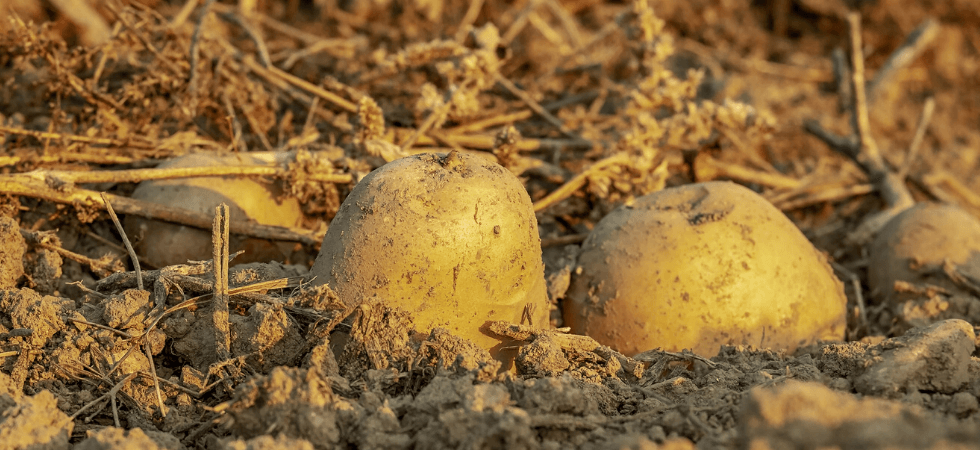
Potato tubers that develop under the surface of the greenhouse soil should not be exposed to sunlight. They should be kept away from sunlight otherwise they will turn green.
Hilling step should be done in the morning when potato plants are at their tallest. Other times of the day when the temperature is very high plants start drooping.
The potato tuber needs 1 to 2 inches of water per week. So maintaining uniform moisture, particularly from the time when potato sprouts become noticeable as late as several weeks after they blossom. The tubers can loose their natural form and shape if not provided with enough amount of water like at the time of planting.
When the tuber is 6 inches tall, before the potato plant bloom the last hilling should be done at this stage. Hoe the dirt up around the base of the plant in order to cover the tubers as well as to support the plant.
Hilling is a necessary step while planning to plant and grown potatoes inside the greenhouse. As it keeps the potatoes from getting sunburned, it ultimately causes them to turn green and produce a chemical called solanine. Solanine gives off a bitter taste and is toxic.
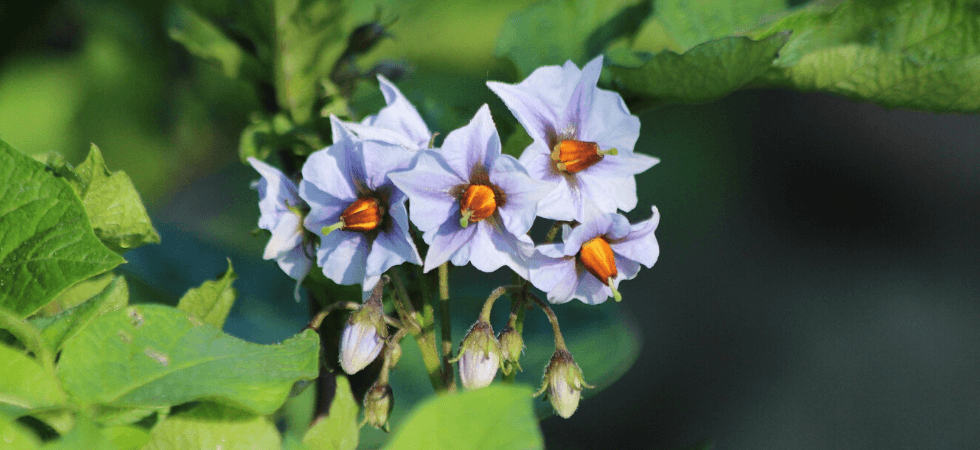
It is the major potato pest all over North America. In spring the adult beetles become active, around the same time when potato plants appear on the ground. Both larvae and adults completely defoliate potato plants. They can be controlled by predatory birds or with Diatomaceous Earth (food grade) it is a soft, siliceous sedimentary rock that kills insects in the nymph state, it is a non-toxic way to control pests in the greenhouse. If the problem persists, then use Spinosad which is an organic pesticide, few sprays of it will be enough to get rid of colorado potato beetles inside the greenhouse.
There are other potato pests too like aphids and flea beetles and we already have shared an article on how to deal with harmful insects using other beneficial insects in the greenhouse.
Potatoes like to grow in acidic soil with a pH not more than 5.2. Potato scab is caused by a high soil pH. To avoid potato scab, dust potatoes seed with sulfur before planting. Some greenhouse planters recommend adding pine straw on top of the potatoes when planting, will aid in natural anti-bacterial elements to the potato being planted inside the greenhouse.
There are two categories of potatoes that need to be harvested. Greenhouse planters name them as ‘new potatoes’ and the ‘mature potatoes’. The new potatoes are those that are harvested early because of their small size and tender skin. They are ready for harvest 2 to 3 weeks after the potato plant stops flowering. However, for mature potatoes, you need to wait for about 2 to 3 weeks. After the plant foliage has died back. This needs a lot of patience. Before you start harvesting the tops of the vines or lianas have to have fully dried. Allow the potatoes to develop a thick skin before 10 to 14 days of harvesting then cut browning foliage to the ground. Potatoes might rot if you wait too long. So avoid it.
Before harvesting toughen up greenhouse potatoes for storage, by not watering the plants after mid-august.
After the foliage has died, dig up a potato to see if the skins rub off easily. If it does, your potatoes are not ready to harvest they should be left in the ground for a couple of days. The mature potato skin does not rub off easily as it is thick and firmly attached to the flesh.
Starting digging potatoes when the first hard frost is expected. Though it can tolerate light frost.

Start digging potatoes not to puncture the tubers. Careful not to cut or bruise potato skin. If the potatoes got cut during digging it will rot during storage.
The greenhouse soil should not be compact so that it will be easy to dig potatoes. Before placing potatoes in bags make sure they are air-dry and the soil is not wet.
Do not let potatoes turn green by placing them for longer periods under the sun just after you have dug up from your greenhouse. Due to the presence of solanine in green potatoes, they taste bitter and if eaten can cause diarrhea and vomiting. If there is notable greening it is advisable to throw them out and if small spots are seen then it can be cut off.
After harvesting potatoes let them sit in a dry, preferably cool area with temperature ranging from (45-60°F / 7-15°C) for up to 21 days. This will let potato skins to cure, making them be stored for longer periods of time.
Make sure you have brushed off any soil on the surface of the potatoes, after curing. Again store brush off soil potatoes in a cool temperature 45° to 50°F (7° to 10°C), dark place with good ventilation. If potatoes are properly stored, they will be fresh for a month. Potatoes that have turned green, wrinkled, or have many sprouts then it is advisable to throw them away.
Keep this in mind never to store potatoes with apples; the ethylene gas emitted from the apples will spoil the potatoes.
As mentioned earlier that potatoes need to be stored in a cooler place this does not mean to store them in the refrigerator.
Never wash potatoes right after you dig them from your greenhouse or buy them at a store, as it shortens their storage life. Do not wash potatoes until right before you plan to cook them for a meal.

The most common potato varieties that are widely grown in the greenhouse are tan-skinned and red-skinned varieties with white flesh. There are more than 100 potato varieties. We will discuss a few varieties which are broadly categorized into three major classes these are:
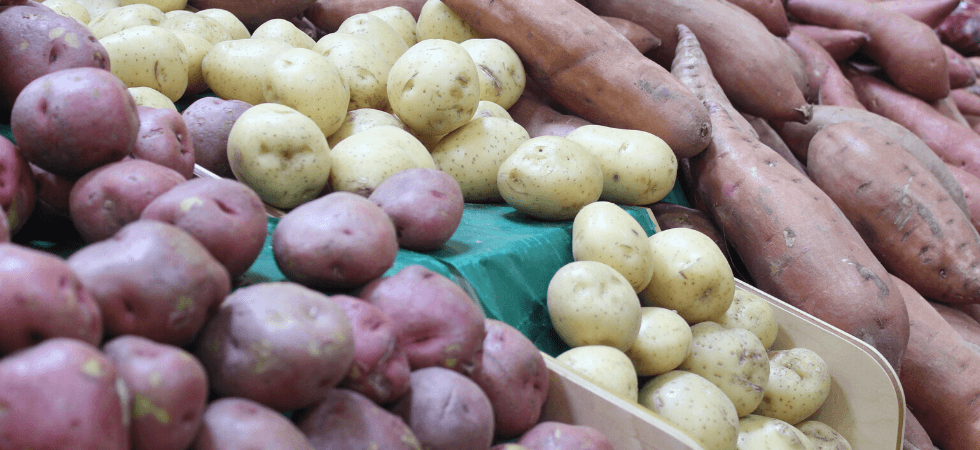
It is highly advisable to take a look at the plant companion chart before planning your greenhouse to have better knowledge about potatoes that are most compatible with which vegetables. Why is the companion plant important? How does it work inside the Greenhouse? It is the technique that is widely practiced by greenhouse planters. We grow certain vegetables alongside each other in the greenhouse in order to harvest the profit of their compatible characteristics, which includes their growth habits, pest-resistant qualities, and their nutrient requirements as well as strong scent plants like lavender, mint, and rosemary; stop grazing animals from grazing and snacking on nearby grown vegetables.
One of the classic examples of companion plants is the Three Sisters trio (climbing beans, maize and winter squash). The maize grows tall and in this way, it provides support to the climbing beans and beans in return supplies nitrogen and on the other hand squash prickly leaves discourage the weeds and pests in the greenhouse.
Our favorite crop plant potatoes companion vegetables are lettuce and spinach that is frequently planted between rows of potatoes to save room in the greenhouse and because they do not compete for nutrients. Some of the herbal companion plants for potatoes are chamomile, basil, yarrow, parsley, and thyme that improve their growth and flavor, while also attracting beneficial insects to the greenhouse. You need to know unfriendly plants that cannot be grown alongside potatoes that include asparagus.
Please do let me know in the comment section how this article helped you with growing, planting and harvesting potatoes. Till then take care!
